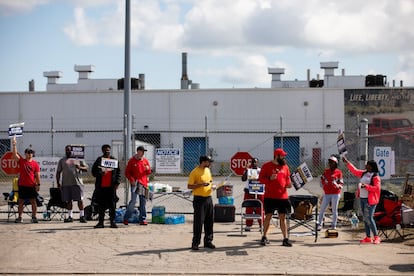The United Auto Workers strike and its economic impact, explained
About 13,000 auto workers have walked off their jobs at targeted factories after union leaders couldn’t reach a deal with automakers. Here’s what you need to know about the UAW strike

On Thursday, September 14, at 11:59 pm, a small percentage of the United Auto Workers union (UAW) walked off their jobs at a General Motors assembly plant in Wentzville, Missouri; a Ford factory in Wayne, Michigan; and a Stellantis Jeep plant in Toledo, Ohio. This is a targeted strike called by Shawn Fain, the current president of the union, who said that this strategy will give the union leverage in contract talks and negotiations. Experts and commentators have said that this strike could cause significant disruptions to auto production in the U.S. and have an important economic impact.
Although both sides have exchanged wage and benefit proposals, they have not reached an agreement yet, which could result in a general strike.
Fain says that the only way to ensure that workers get their fair share is through negotiations with the automakers.
What do workers want?
The United Auto Workers union is seeking raises and better job benefits from automakers General Motors, Ford, and Stellantis.
The UAW is asking for a 40% wage increase over four years. Union officials said that amount matches the raises the top executives at the three companies have received over four years. The raises are also meant to compensate for the increases the autoworkers received in recent years and the concessions the union made to the companies after the 2008 financial crisis.
Fain has said that the union’s demands are “audacious,” but he claims that automakers can afford to raise workers’ pay to make up for what the union gave up to help the companies during the 2008 financial crisis and the Great Recession, when the White House became a controlling shareholder of General Motors to avoid its bankruptcy. Then-president Barack Obama said the government was forced to save the company because its “collapse” would have been “devastating” for the American economy and for millions of Americans.
The union also seeks cost-of-living adjustments that would raise wages to compensate for inflation. It wants a reinstatement of pensions for all workers, improved retiree benefits, and shorter work hours. It also wants an end to a wage system that starts new hires at much lower wages than the UAW pays of $32 an hour.
One of the most important points of discussion is that the union wants to be allowed to represent workers at 10 electric vehicle battery factories, which are mostly built by joint ventures between automakers and South Korean battery makers.
How have negotiations been?
The companies argue that their substantial investments in transitioning to battery-powered vehicles are hindering their ability to offer significantly higher wages. They contend that they are at a disadvantage when compared to non-union automakers like Tesla, which holds a dominant position in the electric car market.
Ford, emphasizing that “the future of our industry is in jeopardy,” expressed last Wednesday their readiness to come to an agreement. They also added, “Rather than planning strikes and public relations events, we should be collaboratively addressing complex challenges.”
G.M. released a statement last Thursday, stating that they have presented a new proposal to the union and are actively involved in continuous, direct, and sincere negotiations to avoid a strike.
Stellantis said that its “focus remains on bargaining in good faith to have a tentative agreement on the table before [...] deadline.”
Fain has dismissed the automakers’ proposals as inadequate to protect workers from inflation and reward them for the work that has made the automakers so profitable. “If the companies continue to bargain in bad faith or continue to stall or continue to give us insulting offers, then our strike is going to continue to grow,” Fain said.
What will be the economic impact?
Several commentators have stated that if the strike is long, it could hurt the U.S. economy, mainly in the Midwest, where most auto plants are concentrated. According to the Anderson Economic Group, if a strike against the companies lasted just 10 days, it would cost them nearly a billion dollars.
Last Friday, President Joe Biden sent two top administration officials to Detroit to meet with both sides. The president has backed the union, saying that the automakers have not fairly shared their record profits with workers.
Sign up for our weekly newsletter to get more English-language news coverage from EL PAÍS USA Edition
Tu suscripción se está usando en otro dispositivo
¿Quieres añadir otro usuario a tu suscripción?
Si continúas leyendo en este dispositivo, no se podrá leer en el otro.
FlechaTu suscripción se está usando en otro dispositivo y solo puedes acceder a EL PAÍS desde un dispositivo a la vez.
Si quieres compartir tu cuenta, cambia tu suscripción a la modalidad Premium, así podrás añadir otro usuario. Cada uno accederá con su propia cuenta de email, lo que os permitirá personalizar vuestra experiencia en EL PAÍS.
¿Tienes una suscripción de empresa? Accede aquí para contratar más cuentas.
En el caso de no saber quién está usando tu cuenta, te recomendamos cambiar tu contraseña aquí.
Si decides continuar compartiendo tu cuenta, este mensaje se mostrará en tu dispositivo y en el de la otra persona que está usando tu cuenta de forma indefinida, afectando a tu experiencia de lectura. Puedes consultar aquí los términos y condiciones de la suscripción digital.
More information
Archived In
Últimas noticias
Most viewed
- Reinhard Genzel, Nobel laureate in physics: ‘One-minute videos will never give you the truth’
- Oona Chaplin: ‘I told James Cameron that I was living in a treehouse and starting a permaculture project with a friend’
- Pablo Escobar’s hippos: A serious environmental problem, 40 years on
- Why we lost the habit of sleeping in two segments and how that changed our sense of time
- Charles Dubouloz, mountaineering star, retires at 36 with a farewell tour inspired by Walter Bonatti










































